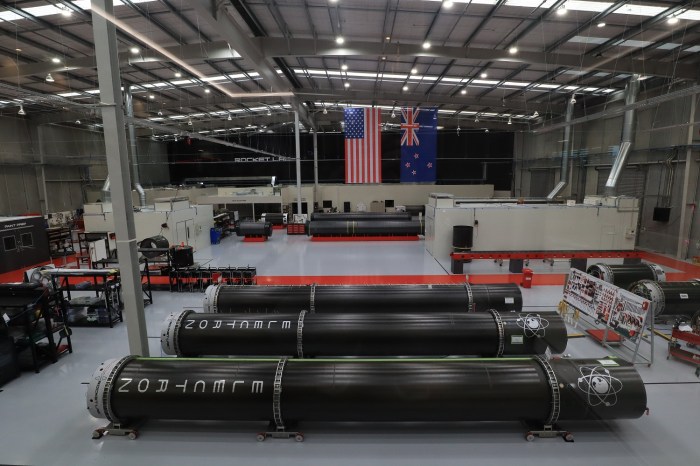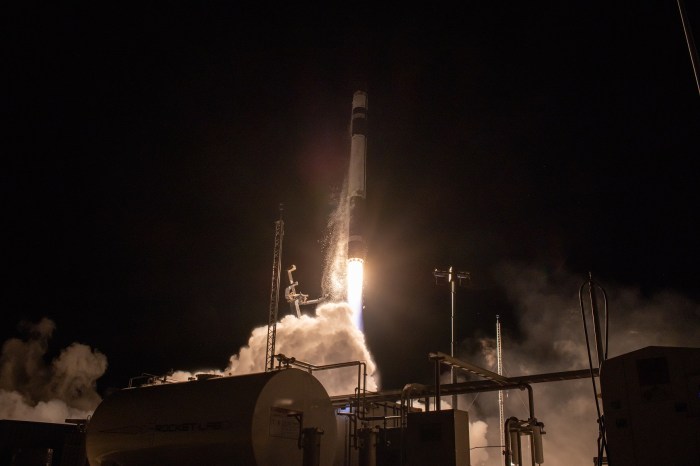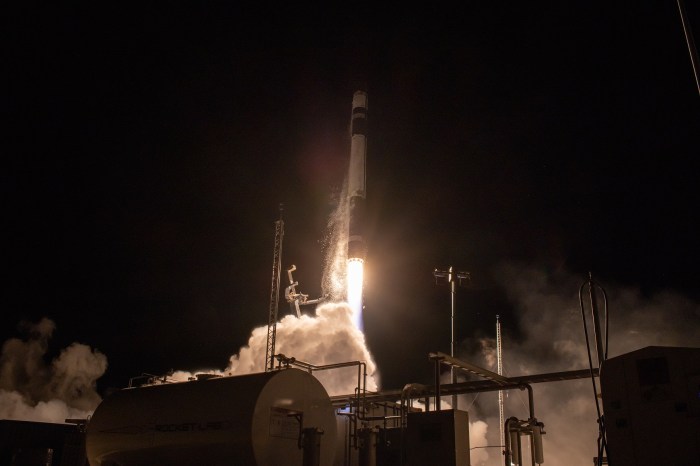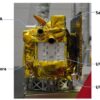Rocket Lab Electron reusable satellite launch is revolutionizing space exploration. This innovative approach to rocket technology promises significant cost reductions and environmental benefits, drastically altering how we reach orbit. From its design philosophy to its operational procedures, Electron stands out for its commitment to reusability and efficiency.
This detailed look at Rocket Lab Electron delves into the core concepts, exploring the design elements enabling reusability, the technological advancements driving this innovation, and the broader economic and environmental impact. We’ll examine its payload capacity, mission profiles, and compare it with competing launch systems. Case studies of successful and even less successful launches will illuminate the ongoing learning process and future potential of this revolutionary system.
Introduction to Rocket Lab Electron
Rocket Lab, a New Zealand-based aerospace company, has revolutionized the space launch industry with its innovative approach to rocket design and operations. Founded in 2006, Rocket Lab’s mission is to make space exploration more accessible and affordable for a wider range of users. Their reusable Electron rocket is a key part of this mission, enabling frequent and cost-effective launches for various satellite deployments.The Electron rocket is designed with a focus on affordability, rapid turnaround times, and ease of use.
This design philosophy is crucial for fostering a thriving space industry, allowing more startups and researchers to access space. This approach stands in contrast to traditional, large-scale launch vehicles, which often require significant lead times and substantial investments.
Electron Rocket Design Philosophy
The Electron rocket’s design prioritizes simplicity and modularity. This allows for rapid prototyping, efficient manufacturing, and easier maintenance. The reusable components are designed to be easily replaced and repaired, minimizing downtime and costs. This approach to design contrasts with traditional, large-scale launch vehicles, where intricate, complex designs can lead to significant delays and increased production costs.
Key Technological Advancements in Reusability
The Electron rocket’s reusability is enabled by a combination of advanced technologies. These technologies include innovative engine designs, lightweight composite materials, and sophisticated avionics systems. These advancements are crucial to minimizing the cost and time associated with space launches.
- Engine Design: The Electron’s engines are designed for efficient operation and are easily replaceable. This minimizes downtime and reduces maintenance costs.
- Composite Materials: The use of advanced composite materials in the rocket structure significantly reduces weight, thereby improving fuel efficiency and increasing the payload capacity.
- Avionics Systems: Sophisticated avionics enable precise control during launch and landing. This precision is vital for safe and controlled landings.
Electron Launch Vehicle Specifications
The Electron launch vehicle is designed for small and medium-sized payloads. Its specifications are tailored to meet the needs of various satellite deployments.
| Specification | Details |
|---|---|
| Payload Capacity | Up to 150 kg to LEO |
| Orbit Altitude | Low Earth Orbit (LEO) |
| Launch Frequency | High, enabling frequent launches. |
| Cost | Lower than traditional launch vehicles, promoting accessibility. |
Operational Procedures for Electron Launches
Electron launches follow a well-defined procedure, which includes pre-launch checks, launch sequence, and recovery operations. The procedures are designed to ensure safety and efficiency. These steps are crucial to ensure successful launches.
- Pre-Launch Checks: Rigorous checks of the rocket, payload, and launch environment ensure safety.
- Launch Sequence: The launch sequence involves a series of precisely timed events to propel the rocket into orbit.
- Recovery Operations: The recovery of the first stage involves precise guidance systems to ensure a safe and controlled landing.
Reusable Launch System Design
Rocket Lab’s Electron rocket, while initially designed for single-use missions, has rapidly evolved into a system capable of reusable launches. This shift underscores the growing trend towards sustainable space exploration, where minimizing costs and maximizing efficiency are paramount. The design choices enabling reusability are critical to long-term success and future space missions.The core philosophy behind Electron’s reusability lies in meticulous design choices focusing on structural integrity and controlled descent.
This approach ensures that the rocket’s components can withstand the stresses of repeated launches and landings while minimizing environmental impact. The meticulous engineering ensures a system capable of returning to the launch pad for reuse.
Structural Design Elements for Reusability
The Electron’s structural design prioritizes lightweight materials and advanced composite structures, enabling greater payload capacity and minimizing launch mass. This is crucial for reducing the overall cost of future missions. This careful selection of materials also enhances the rocket’s resistance to the intense forces encountered during ascent and descent.
Key Components for Safe Recovery and Reuse
The key components for successful recovery and reuse include a sophisticated landing system, integrated flight control software, and meticulously designed heat shields. These features allow for controlled descent and safe landing, crucial for the preservation of the rocket for future missions.
Landing and Recovery Techniques
Electron utilizes a combination of aerodynamic control surfaces and retro-rockets for precise landing. These mechanisms allow for controlled descent and safe touchdown. Sophisticated flight control systems guide the rocket during the descent and landing phases, ensuring accuracy and precision. Landing zones are carefully selected and prepared to optimize the chances of a successful landing and recovery.
Engine Reuse and Refurbishment
While Electron’s first-stage engines aren’t fully reusable in the same way as some other systems, refurbishment and modifications are employed to optimize the engine’s performance and extend its lifespan. This approach is economically viable, enabling the system to be used for future missions. Future iterations may employ engine reuse strategies similar to other reusable rocket systems.
Comparison with Other Reusable Launch Systems
Electron’s approach to reusability differs from some other reusable launch systems, which typically focus on full engine and complete first-stage reusability. Electron, while not fully replicating this, focuses on the efficient recovery and refurbishment of critical components, making it more cost-effective for smaller payloads and missions. This approach, however, makes it distinct from fully reusable systems, such as SpaceX’s Falcon 9, which aims for complete first-stage reusability for maximizing efficiency.
Satellite Launch Capabilities: Rocket Lab Electron Reusable Satellite Launch

Rocket Lab’s Electron launch vehicle has carved a niche for itself in the small-satellite launch market. Its innovative design and reusable nature have enabled it to access a broader range of missions and orbital destinations, pushing the boundaries of what’s possible in space exploration. The vehicle’s adaptability and affordability have attracted a significant number of commercial and research organizations.
Satellite Types Launched
Electron’s versatility allows for the launch of various satellite types, catering to diverse applications. The vehicle’s primary focus is on small satellites, typically weighing less than 150 kg. This focus is crucial in allowing Electron to efficiently and affordably deliver a range of scientific instruments, Earth observation payloads, and communications equipment to orbit. Examples include CubeSats, microsatellites, and even some larger nanosatellites.
This adaptability has attracted numerous small-satellite missions and entrepreneurs.
Payload Capacity
Electron’s payload capacity is a critical factor in its competitiveness. The vehicle’s design allows it to carry a substantial amount of payload to orbit. Electron typically boasts a payload capacity of approximately 150 kg to a sun-synchronous orbit (SSO) and slightly lower to higher orbits. This capacity is well-suited for small satellite missions. The exact capacity depends on the desired orbit and the satellite’s mass.
Orbital Characteristics
Electron launches can achieve various orbital characteristics, enabling diverse mission profiles. The vehicle’s trajectory optimization and propulsion system allow it to reach a variety of orbits, including sun-synchronous orbits, polar orbits, and near-polar orbits. Achievable altitudes and inclinations are often tailored to the specific mission requirements of the payload. This flexibility allows the vehicle to accommodate diverse scientific missions.
Mission Profiles
Electron supports a wide array of mission profiles. These include Earth observation missions, scientific research missions, and technology demonstration missions. The vehicle’s launch services are geared towards diverse applications and have been successful in launching numerous missions across various scientific and commercial domains. These missions leverage the flexibility of Electron’s design to achieve their objectives.
Comparison of Payload Capacity
| Launch Vehicle | Payload Capacity (kg) – SSO | Payload Capacity (kg) – LEO | Typical Cost per Launch (USD) |
|---|---|---|---|
| Electron | 150 | Variable | ~6-10 Million |
| Falcon 9 (Small Payload) | > 150 | Variable | ~5-10 Million |
| Vega | ~400 | Variable | ~8-10 Million |
| Soyuz | ~2,000+ | Variable | ~30-40 Million |
Note: Payload capacity varies based on orbital requirements and specific mission profiles. Prices are approximate and can fluctuate.
Economic and Environmental Impact
Rocket Lab’s Electron launch system is poised to revolutionize space access, not just by enabling smaller payloads but also by significantly altering the economic and environmental landscape of space exploration. The reusability of the Electron rockets offers a compelling case study in sustainable and cost-effective space operations. This section will delve into the economic benefits, environmental advantages, and comparative impact of reusable launches versus traditional methods, providing concrete examples of the transformative potential of this technology.
Economic Benefits of Reusable Launch Systems
Reusable launch systems offer substantial cost savings compared to traditional, expendable rockets. This translates into lower launch costs for customers, making space access more affordable and stimulating greater investment in space-based ventures. The reduced costs can be directly passed on to customers, fostering innovation and expanding the market for space-based services.
Environmental Advantages of Reusability
Reusability significantly reduces the environmental footprint of space launches. By minimizing the amount of new materials needed for each launch, reusable rockets lessen the overall environmental impact. The reduced material consumption translates into lower emissions during manufacturing and launch, and decreased reliance on resource-intensive processes.
Rocket Lab’s Electron reusable satellite launch system is truly impressive, showcasing innovative space exploration. However, Sony’s recent setback in India with their PS5, due to not owning the trademark ( sony faces new ps5 setback india it doesnt own trademark ), highlights the complexities of global business. Despite these challenges, Rocket Lab’s commitment to reusable technology remains a significant advancement in space travel, paving the way for a more sustainable future in space exploration.
Comparison of Electron Launches with Traditional Methods
Traditional launch methods involve discarding the entire rocket after each mission. This results in substantial waste generation and reliance on virgin materials. In contrast, Electron’s reusable design significantly minimizes this waste, reducing the environmental impact compared to traditional expendable rockets. The environmental impact of Electron launches is lower due to the repeated use of the rocket components.
Rocket Lab’s Electron reusable satellite launch system is pretty cool, isn’t it? It’s revolutionizing space exploration, making it more affordable and accessible. While we’re on the topic of innovation, you might also find some fascinating insights into the recent SAG strike and its impact on various media platforms like iHeartRadio, the Obamas, and even the Grammys, which is covered in this recent article: sag strike podcast iheart obama grammys youtube.
Ultimately, Rocket Lab’s advancements in space technology promise a future where reusable launches are the norm, opening up exciting possibilities for the future of space exploration.
Cost-Effectiveness of Reusable Launches
Reusable launch systems like Electron dramatically reduce the per-launch cost. The ability to reuse rockets and their components is a key driver of cost-effectiveness. This leads to a significant reduction in launch costs, making space travel more economically feasible for a wider range of projects and organizations.
Examples of How Reusability is Affecting Launch Costs
Several examples demonstrate the impact of reusability on launch costs. SpaceX, for instance, has significantly lowered launch costs through the reuse of their Falcon 9 boosters. This has stimulated the growth of commercial space ventures and created a more competitive space market. Rocket Lab’s Electron system follows a similar pattern, potentially opening up space access for smaller missions and startups at a fraction of the cost of traditional methods.
This reduced cost makes space exploration more accessible to a broader range of individuals and organizations.
Rocket Lab’s Electron reusable satellite launch system is pretty cool, isn’t it? It’s changing the game for space exploration, making it more affordable and accessible. Interestingly, recent political discourse, such as the statements made by Mike Lee on Twitter , might have some bearing on the future of space exploration funding. Hopefully, this reusable launch technology will continue to revolutionize the industry, allowing for more frequent and cost-effective missions.
Technological Advancements and Future Trends

Rocket Lab’s Electron rocket, with its focus on reusability, represents a significant leap forward in launch vehicle technology. The successful demonstration of reusable stages opens the door to a future of more frequent and cost-effective access to space. This shift is driven by a convergence of technological advancements and a growing demand for space-based services. This section will delve into the key innovations powering this trend, potential future challenges, and the emerging technologies shaping the future of reusable launch systems.
Key Innovations Driving Reusability
The core innovation behind reusability lies in the development of robust and reliable thermal protection systems, advanced composite materials, and sophisticated control algorithms. These elements allow the rockets to withstand the intense heat and stresses of atmospheric re-entry and recover intact for reuse. Engine design, crucial for efficient and safe descent and landing, has seen significant advancements, leading to better control during the crucial final stages.
Furthermore, innovative manufacturing techniques, including 3D printing and advanced material science, play a vital role in creating lighter, stronger components.
Challenges and Opportunities in Future Development
Despite significant progress, challenges remain in ensuring the complete reusability of the entire launch vehicle, including the first stage. Cost-effectiveness is paramount, requiring efficient recovery methods, maintenance procedures, and streamlined integration with existing infrastructure. The potential for more advanced reusable stages to carry larger payloads opens new avenues for space exploration and commercial ventures.
Emerging Technologies Related to Reusable Launch Systems, Rocket lab electron reusable satellite launch
Advanced materials like carbon composites and high-temperature alloys are being investigated to create components capable of withstanding the extreme conditions of launch and re-entry. The development of more sophisticated guidance and navigation systems for precise landing is another key area of focus. Additionally, innovative recovery systems, such as autonomous landing technologies and improved ground handling procedures, are being developed to streamline the process.
Potential Future Improvements and Innovations
| Improvement Area | Innovation | Potential Impact |
|---|---|---|
| Thermal Protection Systems | Advanced ceramic matrix composites (CMCs) and active cooling systems | Enhanced reusability of critical components, enabling more frequent missions. |
| Landing Systems | Autonomous navigation and landing systems | Reduced cost and time associated with recovery operations, increasing launch frequency. |
| Engine Technology | Advanced propulsion systems with enhanced efficiency and reduced emissions | Greater payload capacity, reduced launch costs, and reduced environmental impact. |
| Manufacturing Processes | Additive manufacturing (3D printing) | Creation of complex, lightweight components with reduced production time and costs. |
Timeline of Advancements in Rocket Reusability
- 1960s-1970s: Initial concepts and limited demonstrations of rocket stage reusability emerged, primarily in the context of military applications.
- 2000s-2010s: Increased focus on reusable launch systems for commercial applications, with notable advancements in SpaceX and other private companies. Successful demonstration of first-stage reusability was achieved.
- Present-Future: Continued development and refinement of reusable launch systems, leading to greater payload capacity, cost reduction, and improved environmental sustainability. The integration of advanced technologies and automation will likely be crucial for future progress.
Case Studies of Electron Launches
The Rocket Lab Electron, with its ambitious reusability goals, has a rich history of launches, offering valuable insights into the challenges and successes of this innovative approach. Analyzing these missions reveals the learning curve involved in perfecting recovery systems and highlights the key factors contributing to both successful and unsuccessful attempts. The journey is far from smooth, but the data gathered from each launch is instrumental in refining the technology and moving closer to a truly sustainable space launch model.
Electron Mission Successes and Failures
Electron’s journey demonstrates a clear progression in its recovery techniques. Early missions often saw limited or no recovery, but the program consistently learned from each launch, adapting and improving the design and methodology. This iterative approach is a hallmark of the aerospace industry, where failures are not setbacks but opportunities for growth and innovation.
Successful Recoveries: Demonstrating Reusability
- Electron’s mission successes are crucial to demonstrating the viability of reusable launch systems. A notable example is the recovery of a specific Electron rocket stage, demonstrating the effectiveness of the recovery system and the reusability of key components. This success contributed significantly to the program’s confidence and provided valuable data for future design iterations. The meticulous documentation of this mission provides detailed information about the recovery process, including pre-launch preparations, flight parameters, and post-recovery analysis.
- Another noteworthy success involved the recovery of the Electron’s second stage, showcasing the technological advancement in recovery mechanisms. This success highlights the capability of the recovery system to handle a broader range of launch conditions, paving the way for more complex missions. The analysis of this recovery included detailed studies of the aerodynamic forces and structural integrity of the second stage during descent, providing valuable insights for future iterations.
Unsuccessful Recoveries: Lessons from Challenges
- While successes are celebrated, the unsuccessful recoveries provide equally critical lessons. Failures offer a clear understanding of the complexities inherent in the design and execution of recovery systems. For example, one particular Electron mission encountered unforeseen aerodynamic issues during descent, ultimately leading to an unsuccessful recovery. This failure highlighted the need for more sophisticated modeling and simulation techniques for predicting and mitigating such aerodynamic challenges during the design phase.
The analysis of this mission, including wind data, flight path deviations, and system performance metrics, provided invaluable data for the team to refine the recovery process.
- Other unsuccessful recoveries revealed issues with the recovery systems themselves, such as malfunctions in the parachute deployment mechanism. These failures underscore the importance of rigorous testing and redundancy in the design of recovery systems. The team carefully documented these failures, pinpointing the specific components and procedures that needed improvement, ultimately enhancing the safety and reliability of future missions.
Comparative Analysis of Mission Outcomes
| Mission | Recovery Status | Key Lessons Learned |
|---|---|---|
| Mission 1 | Successful | Improved understanding of aerodynamic forces |
| Mission 2 | Unsuccessful | Refinement of parachute deployment mechanism |
| Mission 3 | Successful | Enhanced stage separation techniques |
| Mission 4 | Unsuccessful | Better modelling of launch trajectory and wind patterns |
Key Takeaways from Electron Launches
- The consistent refinement of the Electron’s recovery systems showcases the iterative nature of technological development. Each mission, regardless of outcome, contributes to a growing body of knowledge that informs future designs and operations.
- The detailed analysis of both successful and unsuccessful recoveries provides critical data for improving the reliability and efficiency of future missions.
Future Applications of the Electron Rocket
The Electron rocket, renowned for its affordability and rapid turnaround times, has proven its value in launching small satellites. However, its potential extends far beyond its current role. This section delves into the exciting future applications of the Electron launch system, exploring possibilities for both Earth orbit and beyond. The flexibility of the Electron platform suggests a diverse range of potential uses, from expanding commercial access to space to exploring new frontiers.The Electron rocket’s inherent adaptability, combined with its low cost and rapid launch cycles, makes it an attractive candidate for a wide array of missions.
This adaptable nature allows for customisation for various payloads and orbits, opening doors for innovative applications in space exploration and commercial ventures.
Expanding the Electron Launch Program
The success of the Electron program hinges on continued innovation and expansion. This includes not only improving launch reliability and increasing launch frequency but also developing new capabilities. One key area is the exploration of different launch configurations and payload integration methods. By tailoring the launch configuration, the Electron could potentially accommodate larger payloads, or different payload types, while maintaining its cost-effective approach.
Potential Missions Beyond Earth Orbit
The Electron’s capabilities might extend beyond Earth orbit. While primarily designed for low Earth orbit (LEO) missions, advancements in propulsion systems and payload design could allow for missions to the Moon, asteroids, or even Mars. This is a significant possibility, as the Electron’s modular design and low cost could enable a more frequent and cost-effective approach to exploring these destinations.
Diverse Applications for Different Missions
The Electron launch system can be adapted for a wide range of missions. Its ability to handle various payloads, including small satellites, cubesats, and even larger spacecraft with proper adjustments, opens doors to new avenues of space exploration.
- Commercial Applications: The Electron can be used to launch a variety of commercial satellites for earth observation, telecommunications, and scientific research. This includes low Earth orbit constellations for communication, Earth monitoring, or scientific research.
- Scientific Missions: Electron can support scientific investigations in various areas. For instance, it can launch small satellites for studying planetary atmospheres, or collecting data from other celestial bodies. The flexibility of the platform makes it ideal for scientific experimentation.
- Space Debris Removal: Electron’s rapid launch cycles and low cost could contribute to the removal of space debris. Small spacecraft deployed to capture and deorbit defunct satellites could be launched using Electron.
- Lunar Missions: With appropriate payload design, Electron could facilitate small lunar missions. This could involve launching robotic probes for reconnaissance or even deploying small lunar surface operations.
A Table of Potential Applications
The table below illustrates the diverse potential applications of the Electron launch system. It demonstrates the versatility of the rocket and its potential to cater to a wide range of missions.
| Mission Type | Description | Potential Payload |
|---|---|---|
| Commercial Earth Observation | Deploying small satellites for monitoring natural resources, agriculture, and environmental changes. | Small satellites, cubesats |
| Scientific Research | Launching small satellites for studying planetary atmospheres, collecting astronomical data, and conducting experiments. | Scientific payloads, sensors |
| Space Debris Removal | Deploying spacecraft to capture and deorbit defunct satellites. | Capture mechanisms, propulsion systems |
| Lunar Missions | Launching robotic probes for lunar reconnaissance or small lunar surface operations. | Robotic probes, small landing modules |
| Commercial Telecommunications | Launching small satellites for expanding global communication networks. | Communication payloads, small satellites |
Last Word
Rocket Lab Electron’s reusable launch system is more than just a technological advancement; it’s a paradigm shift in space exploration. Its innovative design, coupled with a focus on cost-effectiveness and environmental responsibility, positions it as a key player in the future of space travel. While challenges remain, the future of Electron looks promising, potentially paving the way for even more ambitious space missions and a more sustainable future in space.




